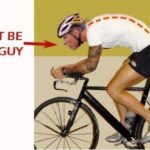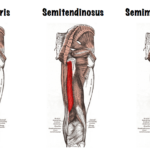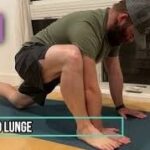
Although we specialize in athletic massage, many people, including athletes, come to our massage practice complaining of lower back pains. Indeed, it is estimated that 80% of people suffer from lower back pain at some point in their life [1]. The majority of these sufferers are between 30 and 59 years old. There are various kinds of back aches, as well as various causes for these aches; for most of them, massage therapy, exercise, and posture modifications are the most efficient way to get relief.
- 1. Various types of lower back pain.
Lumbagos, chronic lower back pain and emergencies are 3 categories in which lower back pains can be classified [1].
- Acute lower back pain.
Acute lower back pain, or lumbago, is a sudden, intense pain of the lumbar region. Its intensity makes it impossible to move for several days; however, the pain then recedes completely and there is no residual pain or loss of movement after that episode. A lower back pain is considered acute if it lasts less than 3 months.
- Chronic lower back pain.
Chronic lower back pain is a low intensity pain that lasts more than 3 months [1]. It can increase with some movements or positions, and usually decreases with rest. Chronic lower back pain often appears after several episodes of lumbagos [2]! This is why after a first episode of back pain, immediate preventive action should be taken (see the paragraph “Chronic pain and prevention of recurrence”).
- Radiculopathy (sciatica).
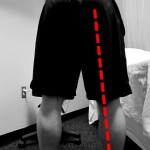
Lumbagos and chronic lower back pains can be accompanied by radiculopathy: the root of a nerve is affected causing neurological symptoms. For example, a sciatica is a lower back pain accompanied by a shooting pain in the posterior part of the leg (photo B). This shooting pain, described as tingling or numbness, corresponds to the trajectory of the Sciatic nerve, meaning that the nerve is pinched or irritated by surrounding structures [3]. The Sciatic nerve can be pinched in between vertebras, or it can be compressed by a tight muscle (often the Piriformis muscle, which is deep inside the Gluteus muscles).
- Emergency!
Cauda equina syndrome, which causes progressive lower limbs weakness and/or bowel or bladder dysfunction, is an emergency and medical attention should be seeked immediately! [1]
The types of lower back pains have different causes.
- 2. Causes for lower back pain.
Lower back pain can be caused by various factors, but for 90% of them, X-rays or MRIs don’t show any signs, the cause is unknown [1]. However, some clinical observations are often found in those suffering from lower back pain such as muscle weakness, misaligned spine or excessive pressure on spine [4].
- Common clinical observations linked to lower back pain.
-muscles:
Lower back pains are often accompanied by muscle spasms, a permanent and painful state of muscle contraction, or muscle knots. Muscles can also be weak, with insufficient core strength: this insufficiency means that the vertebras are not supported enough, making the back more vulnerable. Or muscles can have poor flexibility: their shortened state makes them pull on the vertebras, forcing them out of alignment.
-vertebral alignment:
Palpation may reveal small vertebral misalignments.
-pressure on lumbar disks:
Often, a posture analysis reveals that the lumbar disks, in between the vertebras, suffer from too much pressure: because of bad posture, overweight, repetitive movements…
All these risk factors can be decreased through massage therapy, exercise and posture modifications.
- Discernable causes for lower back pains
Only a small proportion of sufferers present discernable organic conditions such as:ante-spondylolisthesis (vertebras have slid forward), retro-spondylolisthesis (vertebras have slid backwards), malformations such as scoliosis, vertebral compression due to osteoporosis, fractures, cancer, infection… In these cases, a particular medical or surgical treatment is recommended; however, an accompanying treatment of massage therapy, exercise and posture education is always necessary as well as a preventive way to protect the lower back [12]. Moreover, even when a discernable cause is found, there is often also one or more of the three previous observations that coexist with the specific cause.
A thorough analysis of muscles, vertebral alignment and posture helps all lower back pain sufferers to find the causes and relieve some of the symptoms.
- 3. A Clinical examination can reveal possible causes for lower back pain.
Knowing that there are risk factors for lower back pain, whenever clients comes to our massage practice complaining of back pains, we assess their muscles, vertebral alignment and posture, within our means.
- Muscle tone, strength and flexibility analysis
-muscle tone
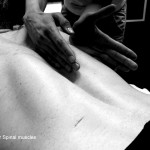
To assess muscle tone, it is necessary to feel the muscles: this is generally done during a massage, more specifically, a deep tissue massage, so that even the deeper muscles can be analyzed for tightness or knots. The most common muscles that present tightness or knots are the spinal muscles, those longitudinal muscles that are the pillar of the spine (photo C).
-muscle strength
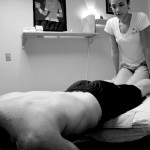
The muscles that support the spine are the extensors (Spinals and Gluteals), the flexors (Abdominals and Hip Flexors) and the Obliques, often referred to as the core muscles, because together, they form a “belt” around the lower back [6]. Core strength can be assessed with the Sorensen and Shirado tests [5]. The Sorensen test is used to assess the spinal extensors (photo D). The person is positioned face down, at the top of the table, with the trunk bent forward hanging outside the table, while the therapist hold down the ankles firmly. The person then lifts up until the spine is straight, and holds the position for as long as possible. Healthy extensors allow to hold the position for at least 2 minutes.

The Shirado test is used to assess the spinal flexors (photo E). The person is positioned on the back, feet elevated on a chair so that the hips and the knees are bent at a right angle. The person then lifts the shoulders off the table and tries to maintain that position as long as possible. As for the previous test, healthy flexors allow to hold the position for at least 2 minutes.
-muscle flexibility
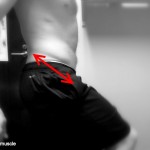

Muscle flexibilitycan also affect the lower back. Tight muscles that are inserted close to the spine, such as the hamstrings or the hip flexors (the Psoas, for example, see photo F), can pull on it and create pain.
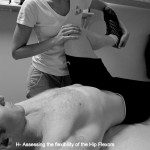
An easy way to test the flexibility of the hamstrings and the back is to measure the distance from the fingers to the ground when the person bends forward (photo G) [7]. To test the hip flexors, the bent knee is pushed towards the chest, with the opposite leg straight (photo H).
- Morphostatic Analysis
A morphostatic analysisis an observation of the immobile standing form, from the side, and from the back [8].
-profile, standing:
A standing profile analysis should show 3 spinal curves: lumbar, thoracic and cervical (photo I-A). These curves can be accentuated (photo I-B) by overweight, pregnancy or megalomastia (large breasts).These curves can also be decreased (photo I-C) by sitting or standing with a rounded back, or because of scoliosis.
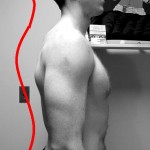
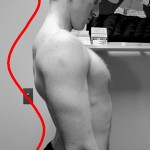

-back, standing:
A standing back analysis can also show imbalances. Standing straight, the hips and the shoulders should be horizontal and parallel, making the spine straight from this angle (photo J-A). If one hip or one shoulder is elevated, for instance from carrying a handbag on the same shoulder every day, the spine is no longer straight and suffers from unnatural curves (photo J-B).
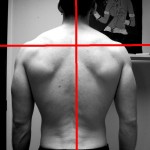

In all cases, any unnatural curvature of the spine puts increased pressure on the intervertebral disks, resulting in lower back pain.
- Static or active Posture Analysis
A posture analysis can also be done for everyday activities. There is a proper way to position your spine whenever you are sitting, cooking, sleeping, walking, lifting weights… If incorrectly positioned, the spine is once again put under additional pressure. For example, when sitting straight, the spine must have the same curves that are present when standing (photo K-A). In an incorrect position, the cervical and thoracic curves are often accentuated while the lumbar curve is reversed (Photo K-B). Your therapist will assess those positions and movements that you do often to check and advise you on proper positioning. For instance, a golfer and office clerk will be asked to reproduce his golfing swing as well as his sitting position so that his therapist can assess any incorrect form.
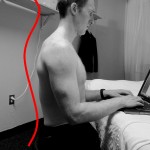
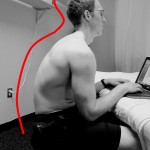
- Vertebral mobility
The spine needs to be mobile in all its areas: if an area is less mobile, the areas around it will be overworked to compensate for this loss of mobility, and as a result there will be pain.
To test the spine’s range of movement, the basic tests are the following [9]:
-the forward bend (photo L) assesses the spine flexion
-the backward bend (photo M) assesses the spine extension
– the twist (photo N) assesses the spine rotation
– the sideway bend (photo O) assesses the spine inclination.

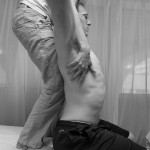
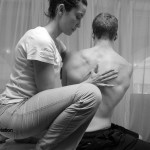
photo N
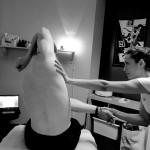
Each movement is observed and felt for different parts of the spine, to point out areas that may not move as well as others.
Once the back pain is analyzed, a treatment can be put in place.
- 4. Treatments of lower back pain
- Treatment for non-specific causes:
The treatments differ for acute or chronic pains. But remember that an acute lower back pain can be a precursor for chronic pain: therefore, preventive treatment is necessary for all cases!
-acute pain
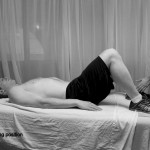
In the acutephase of a lower back pain, most people contact their primary physician and get pharmacological treatment: since the cause of the pain is non-specific, several different medications are tried, such as muscle relaxants, pain relievers, or anti-inflammatory medication [10]. Hot or cold therapies are natural physical agents that relax muscles (heat) and numb pain (cold). Massage therapy is also recommended in the acute phase for pain relief. No more than 3-4 days rest, lying on the back, on a hard surface, legs bent, is recommended (photo P). After that, being somewhat active makes recovery faster, and a preventive treatment can start [13].
-chronic pain and prevention of recurrence
For chronicpain or for prevention, there are three parts of treatment.
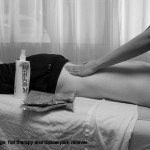
The first part consists of decreasing pain through massage therapy on the whole back, hot and cold therapy on the specific pain area, and/or topical pain relievers (photo Q) [12].
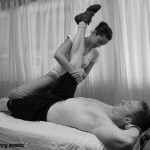
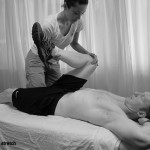
The second part consists of increasing muscle flexibility and vertebral mobility with a therapist [6]. Muscles that need stretching are: the hamstrings (photo R), the hip flexors, the Gluteus (photo S) and the Piriformis muscles, most importantly. Spine stretches are spine rotation, flexion, extension and inclination. Working with a therapist ensures that the specific muscles or spine areas are targeted, it allows for deeper stretches and increased gain of range of movement, and it is a preamble for the third part of the treatment which is integrating treatment in the everyday lifestyle.
The third part of treatment is change in habits through education of posture modification [11].
One has to learn exercises to reproduce on a regular basis at home or at the gym. These exercises target core strength, muscle and vertebral mobility, and are vary varied. For example, a healthy back regimen can consist of:
-core strengthening: do a straight plank (for the flexors and extensors – photo T) for one minute, a side plank (for the Obliques – photo U) for 30 seconds on each side, the whole 2 minutes repeated 4 times.
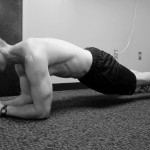
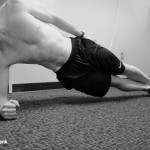
-hamstring and adductor (inside thigh muscles) stretch: lie on the floor, the buttocks against a wall, and the legs straight up (photo V-A). Try to straighten your knees. Once they are straight, spread your legs and let the weight pull them downwards and stretch the muscles (photo V-B). Stay in that position for 5 minutes [1].
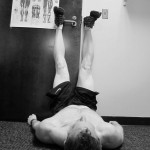
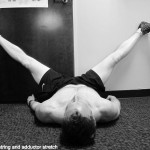
-hip flexor stretch: a deep lunge held 30 seconds on each side (photo W). [1]

-Piriformis stretch: lying on the floor, cross the left leg over the other, then grab your right leg and pull towards your chest. Hold 30 seconds then change sides and repeat (photo X) [1].
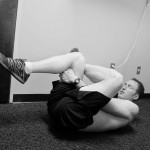
This series of exercises are repeated 3 times a week and can be complimentary of another physical activity. Ideally, these exercises are evaluated on a regular basis by a therapist, personal trainer or workout instructor to be adjusted as strength and range of motion increase and pain decreases.
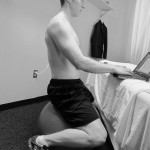
One also has to correct their posture at work or during other pain causing activities. For example, a computer programmer might want to change his regular work chair for an ergonomic work chair or a medicine ball (photo Y).
One can also include a monthly session of massage therapy in their schedule to preventively detect tight back muscles and knots.
One can also team up with a dietician to lose weight to release pressure on the intervertebral disks.
The changes necessary differ for each individual and will be more effective and targeted with guidance from a therapist.
Back pains are very common in our society, and their non-specificity makes them difficult to treat in one unique way. Analyzing morphology, posture, muscle tone and flexibility can make possible causes for a back pain stand out, and therefore, allow for a treatment program to be developed. This can be done with a physician, physical therapist, massage therapist, personal trainer, dietician…: a life-long commitment to protect your back, with their help, will rid you of pain.
REFERENCES
[1] Ullrich P. F., Jr., MD,Lower Back Pain Symptoms and Treatment Options, http://www.spine-health.com/conditions/lower-back-pain/lower-back-pain-symptoms-and-treatment-options (retrieved 3/11/11)
[2] Biering-Sørensen F., A prospective study of low back pain in a general population. I. Occurrence, recurrence and aetiology, Scand J Rehabil Med. 1983;15(2):71-9., http://www.ncbi.nlm.nih.gov/pubmed/6223365 (retrieved 3/11/11)
[4] “National Institute of Neurological Disorders and Strokes” website, Low Back Pain Fact Sheet, http://www.ninds.nih.gov/disorders/backpain/detail_backpain.htm (retrieved 3/14/11)
[5] Rannou F., Poiraudeau S., Revel M., Les lombalgies communes., http://mediatheque.parisdescartes.fr/doc/racine/f/flandinf/107871SorensShirad.PDF (retrieved 3/13/11)
[6] HydeT. E., DC,Back Exercises and Abdominal Exercise Recommendations, http://www.spine-health.com/wellness/exercise/back-exercises (retrieved 3/11/11)
[7] Ruiz S., Evaluation musculaire du lombalgique:, 25 août 2006, http://osteopathe-montpellier.com/evaluation-musculaire-du-lombalgique (retrieved 3/13/11)
[8] Cohen J., Montagnon J., “Cours de kinesitherapie” website, Bilan scoliose, http://www.courskine.fr/scoliose_451.htm (retrieved 3/14/11)
[9] L’examen d’une lombalgie par le médecin de Médecine Manuelle – Ostéopathie
ANMSR Paris 2007, http://www.anmsr.asso.fr/2007/images/documents/8_l_examen_d_une_lombalgie_par_le_m_decin_de_mmo.pdf (retrieved 3/14/11)
[10] Stewart G. Eidelson, MD, Back Pain Treatment Option, http://www.spineuniverse.com/conditions/back-pain/back-pain-treatment-options (retrieved 3/11/11)
[11] ATUL T. PATEL, M.D., ABNA A. OGLE, M.D, Diagnosis and Management of Acute Low Back Pain, American Family Physician, March 15, 2000,
http://www.aafp.org/afp/20000315/1779.html (retrieved 3/11/11)
[12] Stewart G. Eidelson, MD, Back Pain Treatment Option, http://www.spineuniverse.com/conditions/back-pain/back-pain-treatment-options (retrieved 3/11/11)
[13] STEVEN J. ATLAS, MD, MPH, Nonpharmacological treatment for low back pain, The Journal of Musculoskeletal Medicine. Vol. 27 No. 1 , http://www.musculoskeletalnetwork.com/pain/content/article/1145622/1507555 (retrieved 3/11/11)
This article and/or video are for educational purposes only; do not attempt without your physician’s clearance. If you are in pain or injured, see your physician.
Copyright © Vidal Sports LLC 2018





